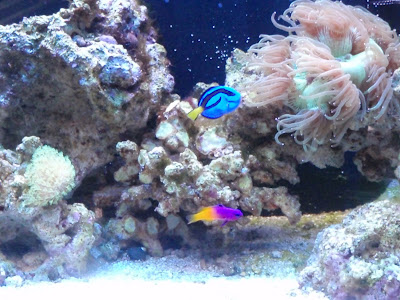


Chantal and Phillip (royal gramma)

Chantal loves the clowns!




Chantal loves the clowns!



--our aquarium!
I have been dying to purchase a Blue Tang (also known as a regal tang and hippo tang; it's scientific name is Paracanthurus Hepatus). Everyone told me this was a bad idea since they are sensitive, get stressed and bullied easily, and tend to get diseases. "They're ick magnets!" an aquarium expert scoffed at the LFS. I was undeterred. The bright blue colors with black streaks and yellow tail! Oh my! I fell for this fish's beauty. Plus, tangs (my favorite group of fish) are peaceful, reef safe, and eat algae. What more could you want? Anyway, I was tired of playing by all the rules. It was time to venture out and be bold. I spotted some healthy juvenilles swimming around at my favorite LFS and couldn't resist. They were fresh in from Hawaii. I purchased the healthiest gal (we can't tell the sex but decided to proclaim her female since our tank was becoming male- dominated).
We brought Chantal home and carefully acclimated her to the tank. I even gave her a little cup to hide in the acclimation chamber. I dimmed the lights and carefully netted her into the tank. I held my breath and waited. I had been told she would be shy and skittish, hiding in the live rock for days. The "experts" told me I would probably not see much of her for the first week or so. Surprisingly, she started taking over the tank, bullying the other fish! I guess she had heard the motto from prison: "Make someone your bitch the first day or else be someone else's." Luckily, the other fish didn't fall for her bluff and pretty much ignored her false charges and zipping about the tank. She immediately started gulping up copepods pouring in from the refugium. A quick check on the internet confirmed that the blue tang's diet consists mostly of plankton in the wild (not algae as I had falsely been told).
I have high hopes for her! She's quite the diva and spends most of her time swimming out in the open, eating copepods. She's very frisky! Not at all what I expected. I am keeping my fingers crossed that she stays healthy.
Blue Tang Facts
Other names: regal tang, hippo tang, yellow-tailed blue tang
Other names: regal tang, hippo tang, yellow-tailed blue tang
Scientific Names: Paracanthurus Hepatus
Diet: Herbivore. Eats mostly plankton but supply a varied diet of meaty foods and greens. Provide kori or seaweed on a veggie clip.
Size: adults group up to 12 inches; when she starts to grow too big for our 75-gallon tank, we'll either have to trade her out :*( or get a bigger tank :) An ideal tank size is 200 gallons.
Region: Hawaii
Disposition: shy and hides in rock and caves but also likes to swim a lot; high metabolism; tends to get stressed easily, making it susceptible to diseases like ick, marine velvet and lateral line erosion.
Disposition: shy and hides in rock and caves but also likes to swim a lot; high metabolism; tends to get stressed easily, making it susceptible to diseases like ick, marine velvet and lateral line erosion.
Note: has sharp spines that can cut if handled (typical of surgeonfish)
Other: peaceful and reef compatible
Links:
Thanks for discussing about Fish Expert. I appreciate your work and this blog post. Great work, keep this carry on. I would like to visit again and like to read some more interesting information.
ReplyDelete